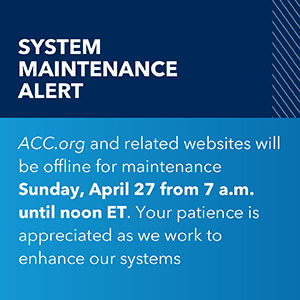Update to ACC/AHA HF Performance and Quality Measures: Key Points
- Authors:
- Kittleson MM, Breathett K, Aguilar D, et al.
- Citation:
- 2024 Update to the 2020 ACC/AHA Clinical Performance and Quality Measures for Adults With Heart Failure: A Report of the American Heart Association/American College of Cardiology Joint Committee on Performance Measures. J Am Coll Cardiol 2024;Aug 8:[Epub ahead of print].
The following are key points to remember from the 2024 update to the 2020 American College of Cardiology/American Heart Association (ACC/AHA) clinical performance and quality measures for adults with heart failure (HF):
- This 2024 focused update of the 2020 ACC/AHA Clinical Performance and Quality Measures for Adults With Heart Failure reflects changes from the recent 2022 AHA/ACC/Heart Failure Society of America Guideline for the Management of Heart Failure. Described in this document are evidence-based performance measures that are appropriate for public reporting or pay-for-performance programs, as well as quality measures that may be useful for quality improvement but may not have as strong of an evidence base. Exceptions and exclusions to these measures are noted.
- No performance or quality measures were retired or revised from the 2020 ACC/AHA Clinical Performance and Quality Measures for Adults With Heart Failure document. Three new performance measures (PM) and six new quality measures (QM) were created for this focused update, which are highlighted below.
- PM 1: Percentage of adult patients with HF with reduced ejection fraction (HFrEF) that are started on guideline-directed medical therapy (GDMT) at time of discharge from an HF hospitalization. This includes angiotensin receptor-neprilysin inhibitor/angiotensin-converting enzyme inhibitor/angiotensin receptor blocker, evidence-based beta-blocker, mineralocorticoid receptor antagonist, and sodium-glucose cotransporter-2 inhibitor (SGLT2i).
- PM 2: Percentage of adult patients with HF with preserved EF (HFpEF) and hypertension with optimal blood pressure (BP) control (systolic BP <130 mm Hg and diastolic BP <80 mm Hg). This uses the most recent measurement from the last 12 months and includes both the inpatient and outpatient setting.
- PM 3: Percentage of adult patients with symptomatic HFrEF prescribed an evidence-based SGLT2i within the last 12 months. This includes prescriptions at hospital discharge or in the outpatient setting.
- QM 1: Percentage of adult patients with HFpEF or HF with mildly reduced EF (HFmrEF) prescribed an evidence-based SGLT2i within the last 12 months. This includes prescriptions at hospital discharge or in the outpatient setting.
- QM 2: Percentage of adult patients with HF screened for social determinants of health and an action plan to close identified gaps. This includes patients in the inpatient and outpatient settings and may involve a multidisciplinary team.
- QM 3: Percentage of patients of childbearing potential with HF or a cardiomyopathy that have received counseling regarding contraception, risk of cardiovascular events in future pregnancies, and plans for future pregnancies.
- QM 4: Percentage of adult patients with prior HFrEF and now with HF with improved EF (HFimpEF) that are still prescribed HF GDMT in the outpatient setting.
- QM 5: Percentage of adult patients with HFrEF receiving optimal GDMT prior to receiving mitral valve transcatheter edge-to-edge repair for severe functional mitral regurgitation.
- QM 6: Percentage of adult patients getting bone scintigraphy scanning for suspected cardiac amyloidosis that have undergone serum and urine monoclonal protein screening.
Clinical Topics: Heart Failure and Cardiomyopathies, Acute Heart Failure
Keywords: Cardiac Amyloidosis, Heart Failure, Sodium-Glucose Transporter 2 Inhibitors

